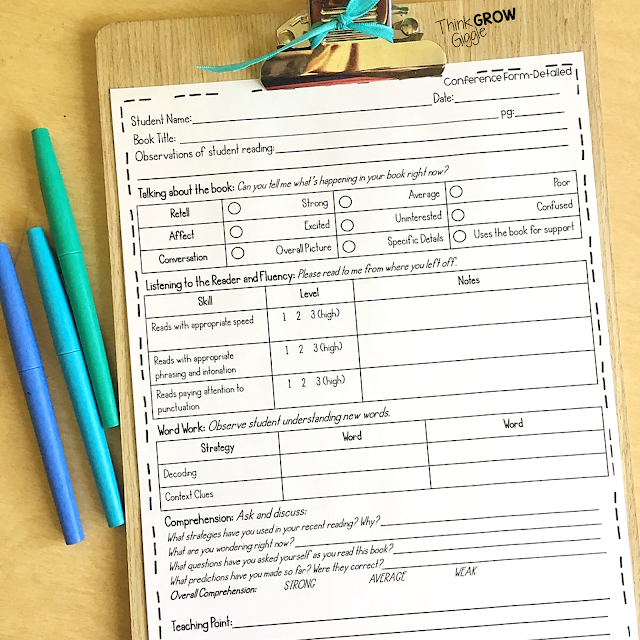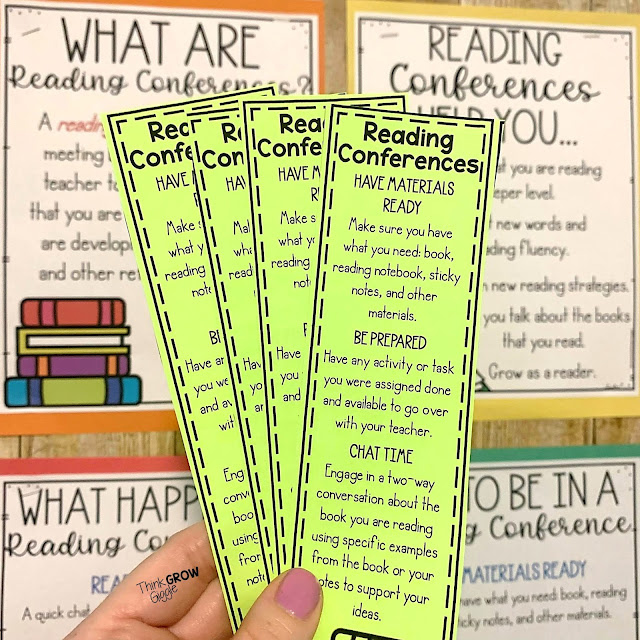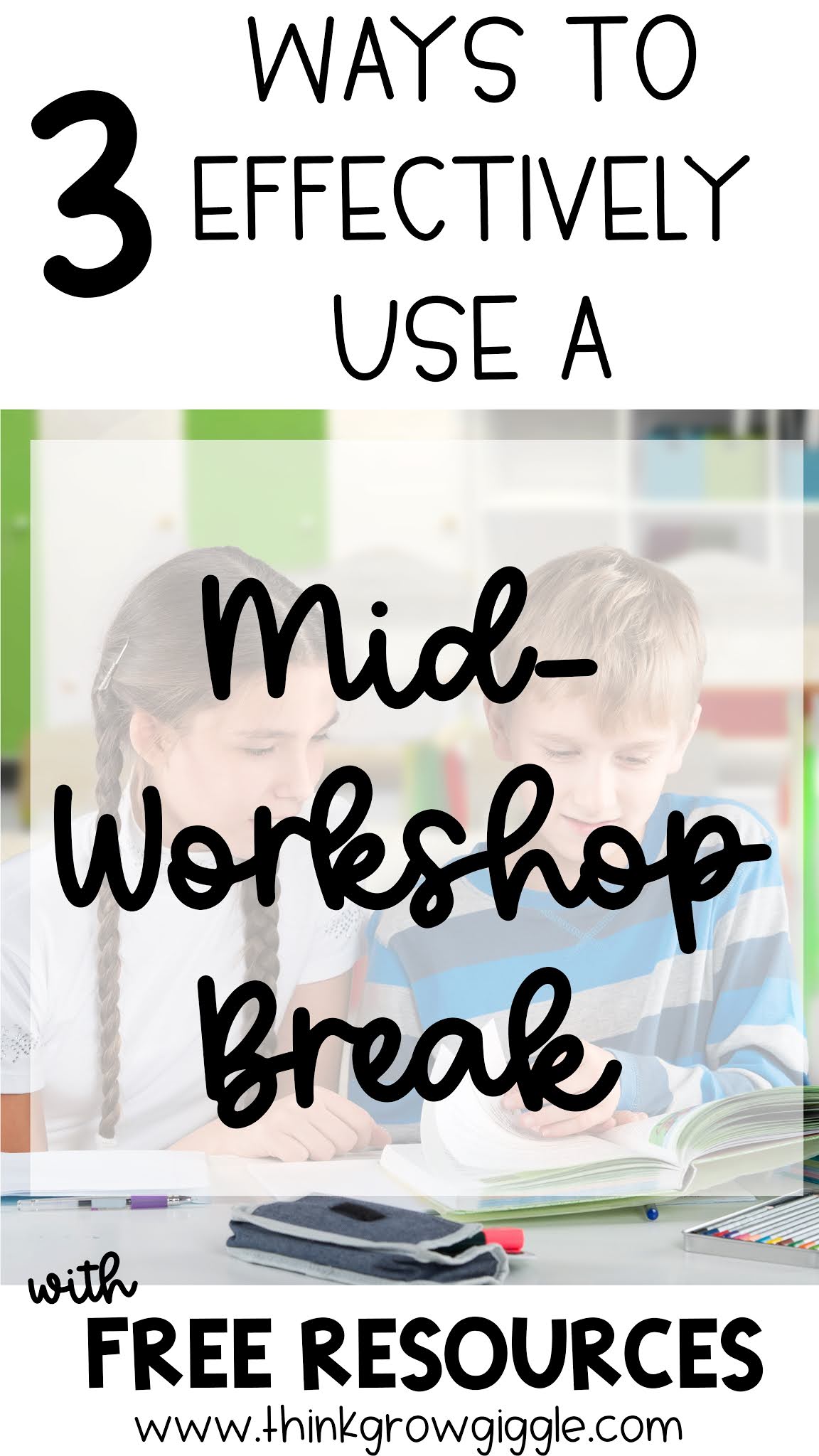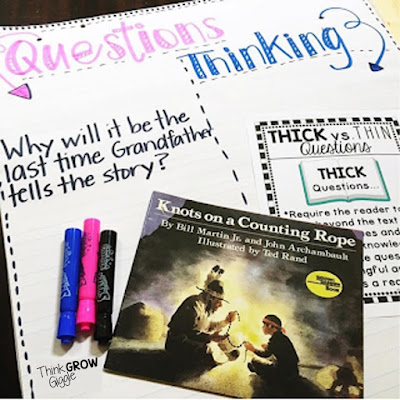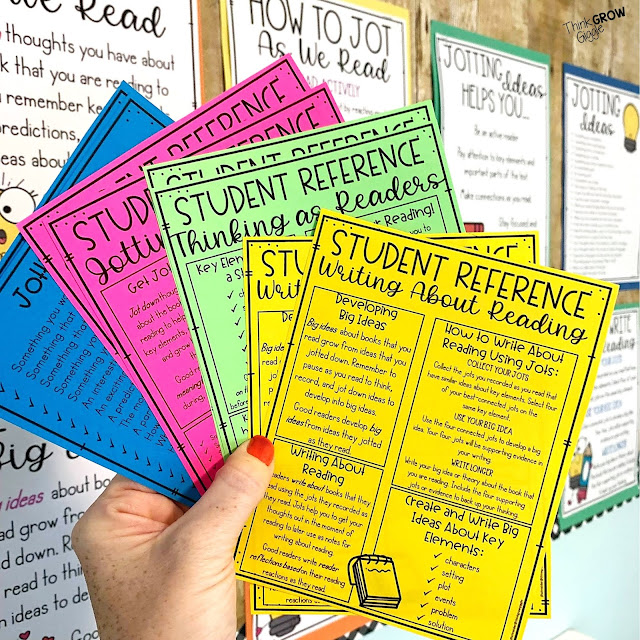Conducting reading conferences with your students is an important part of reading workshop.
A teacher-student reading conference takes place during independent reading time within your reading workshop block. During this quick one-on-one meeting time, the teacher listens to the student read, they discuss the book that they are reading through discourse about the reading strategies that the student is using, and the teacher compliments the reader and gives them a suggestion or tip to use as they continue to read.
By conferring with your students you are giving them one-on-one time devoted solely to improving their individual reading skills. It is reading differentiation at its best! Reading conferences allow students to get tailor-made individualized mini-lessons suited just for them!
It is important to make the most of the time that you have for your reading conferences. This will ensure that the student you are conferring with gets reading strategy work that will help them get stronger as a reader. Grab a reading workshop kit for FREE below.
Here are some ways that I have found that work for me to make the most of your individual reading conference time.
Be Organized
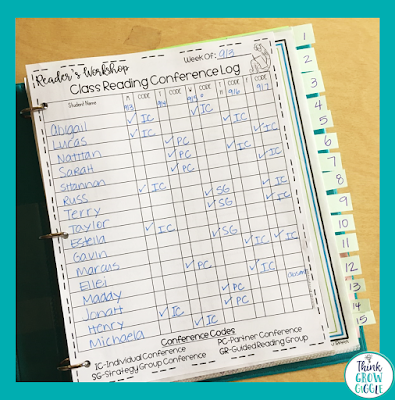 Planning for reading conferences can be challenging. Students that you planned on meeting with might be absent during your reading time, your mini-lesson may run over time, and students you thought were ready to work alone, may need a little extra support to help get started independently. All of these interferences cut into your reading conference time, meaning you will not meet with as many students as you had planned. My goal is to always meet with about five students each day. This ensures that by the end of the week I would have met with all of my students at least one time.
Planning for reading conferences can be challenging. Students that you planned on meeting with might be absent during your reading time, your mini-lesson may run over time, and students you thought were ready to work alone, may need a little extra support to help get started independently. All of these interferences cut into your reading conference time, meaning you will not meet with as many students as you had planned. My goal is to always meet with about five students each day. This ensures that by the end of the week I would have met with all of my students at least one time. To help me stay organized, I keep a reading conference log right at the front of my binder. It is completely organized to keep track of the conferences that I have had and which type of conference it was. Although traditional reading conferences are between the teacher and one student, I also utilize partner conferences and strategy group conferences as teacher conferring opportunities. These type of conferences do not occur as often, but there are days that students work together on reading tasks, so when I meet with them as a pair, we all confer together! I also mark this sheet with information that will help me keep track of student growth such as absences or when a student is pulled out of my classroom for additional services. This page serves as a great tracking system! This sheet is also helpful for planning. Before reading workshop begins, I can quickly look at this page and know which students I will need to confer with that day.
Be Prepared
 Having a reading conference toolbox is a great way to be prepared for all of your reading conferences.
Having a reading conference toolbox is a great way to be prepared for all of your reading conferences. Inside my reading toolbox are the essentials that I need to meet with each student for their reading conference. It contains a reading workshop conferring guide to keep me on track, a previously read picture book from the current unit of study, so that we can refer back to it together to review strategy work, conference datasheets for me to take notes on, reader take away cards so that I can leave the students with a handwritten compliment and suggestion, and of course pencils, highlighters, pens, and sticky notes!
Having student data sheets are a must! The more detailed notes you take during the conferences, the better you are able to help each student as an individual. You can use a plain notebook and take detailed notes, making sure to note the student's name, date, and book that they are reading, or you can use very detailed note sheets to track reading fluency, include strategies, and your entire discussion. Both work well, so pick the style that works for your! Just be sure to keep track of each and every conference that you hold with each student.
Be Positive
 Always, always, start your reading conferences off with a positive vibe, to ensure that the students are excited to see you approach them for a reading conference. When you first get next to your student for a conference be sure to give them a compliment about what they are doing. Some suggestions for compliments could include student organization, the student getting lost in the book, student taking notes, student use of reading strategies, or student fluency after you listen to them read. The more positive and celebratory that you are, the more the student will continue to do what you celebrated as they read independently. Be sure to always mix up your compliments each time you meet with a student.
Always, always, start your reading conferences off with a positive vibe, to ensure that the students are excited to see you approach them for a reading conference. When you first get next to your student for a conference be sure to give them a compliment about what they are doing. Some suggestions for compliments could include student organization, the student getting lost in the book, student taking notes, student use of reading strategies, or student fluency after you listen to them read. The more positive and celebratory that you are, the more the student will continue to do what you celebrated as they read independently. Be sure to always mix up your compliments each time you meet with a student.Be Present: Leave Your Voice Behind
I love using these reader take away cards to help students stay on track while they independently read. I use them in two different ways.
The first way I use them is during our reading conference. I will take quick notes on each card as we speak, including a compliment and a suggestion. When I leave, the reader gets to keep this card. They can use it as a bookmark, keep it in their reading folder, or staple it to their reading notebook page. When students forget their focus or goal, they can take out the card and remember our conversation during our conference and “hear” my voice once again coaching them along.
I also use these reader cards on days that I did not meet with a student to confer, especially if a few days have passed. I will collect student notebooks or activity pages and correct it, and fill out a reader card with a compliment and suggestion just as if we were having a conference. When the student’s work is returned, they will see the reading card and know exactly what they are doing well and what they need to focus on as they continue to read. These cards are a great way to keep track of your conferences, too!
Reading conferences are a powerful tool to help your students grow as readers, but they must be planned and purposeful, just like all of the other elements of reading workshop. These tips and strategies will help you to make the most of the time you have to confer with your students.
If you are looking for more tips, check out the professional reading book: Conferring with Readers. I love this book and refer to it often! It is a great professional read to help you understand the ins and outs of reading conferences.
*affiliate links: “Think Grow Giggle is a participant in the Amazon Services LLC Associates Program, an affiliate advertising program designed to provide a means for sites to earn advertising fees by advertising and linking to Amazon.” (source: Section 5)








